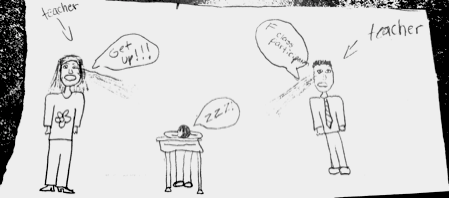What Kids Say about Inclusion Classrooms
A MiddleWeb Blog

Do you think about a smoothly run classroom where each teacher has consistent, specific, and meaningful roles? Or do you think about a chaotic classroom scene where two teachers are not in sync, which leads to lost instructional time. Or, equally as sad, do you think about one teacher doing most of the teaching, while the other teacher is seldom actively involved in the teaching process?
It is crucial for co-teachers to develop a professional instructional relationship. The way they interact in the classroom, and the way they interact with the students, shapes the way kids in the classroom think about what inclusion means.
So far, Laurie and I have shared perceptions of co-teaching through the lens of educators. I’d like to devote this post to the perspective of the students. Well, at least some students — my 7th grade study hall class, in fact.
In this class, students have time to quietly study, but I also have the great pleasure of discussing meaningful questions with them. Recently, I asked them to explain their thoughts about having two teachers in the room.
These 7th graders are all general education students who have had a variety of experiences being a part of inclusion classrooms. They had lots of observations to share — and some even took the time to express their ideas through drawing. Here’s what they had to say:
Q: What do you think about having two teachers in the room?
I personally feel like it is very important to have a second teacher in the room. While one teacher is teaching the class, the other teacher can make the rounds and help single students at a time if they don’t get the subject.
I like how there is double the help.
I like that there are more than one person to help me. I don’t like that it’s harder to talk to a friend.

It’s good because there is more than one person watching the class. Also, if one is sick, there is always one teacher left who knows what’s going on, so she can tell the sub the right way to do things.
Sometimes it’s confusing because they cut each other off all the time and I don’t always know what they’re talking about.
I wish the co-teacher would just stay quiet—she talks too much. She is always interrupting the real teacher.
I hate it because you can’t get away with anything! The second teacher always says, “Give me your gum!”
One good thing is there is double the help. One bad thing is you can never slack off without being seen.
I like it when the co-teacher explains what’s going on because the real teacher usually speaks too fast. But having the second teacher helps us to know what we have to do.
Having two teachers means double the supervision. Let’s say you want to slack off because you’re tired and you to let go for five minutes. That second teacher, or even worse, both teachers could be there and watching you.
Sometimes it depends. It is usually a good thing because if one teacher is confusing there is a second teacher there to help you to understand.
The Takeaway:
Generally, the kids view having two teachers as a positive thing. Yet, it’s interesting that many students see one teacher (typically the general education teacher) as the “real” teacher. And the special education teacher is the “co-teacher,” where co-teacher seems to signify “helping teacher.” Is it possible for the two teachers to plan ahead and implement instruction in ways that depicts both teachers as “real” teachers? And both teachers as “co-teachers”?
Q: Why do you think some classes have two teachers?

I believe that there are two teachers because some kids need extra help.
They help the special ed kid. (OK, so here’s a good place to discuss the need for person first language.)
There are two teachers because they need to help the kids with learning needs.” (OK, nice person first language, but don’t all students have learning needs?)
My opinion is that there are two teachers in the room because some kids in the class need extra help.
The Takeaway:
Apparently these kids get the fact that some students need additional support in the classroom. But clearly a better message needs to be sent. And the message needs to be sent by both teachers through the modeling of parity, respect, valued roles and responsibilities, and hard work.
Q: Are the two teachers there for all the students?
And in one flash of a second the group responded in unison with a drawn out, echoing, Noooo.
I must admit, although I wasn’t surprised, I was a bit disheartened. But who wouldn’t be?
So: Check Your Inclusion Pulse

CheckPoint #2: Sit down with your co-teacher — review your roles and responsibilities. Set the classroom stage so that you both will be perceived as “real…co-teachers” by your students. Here are six steps for successful co-teaching, provided by the National Education Association that could help you to keep your focus.
And then check in with us, and tell us how it’s going…
































Elizabeth, I love this! I am going to survey the kids I co-teach with this week and see if 6th graders’ answers are any different than 7th graders. I too have noticed kids sometimes refer to the general education teacher as “the real teacher” (implying the special ed. co-teacher must be fake?). This comment used to bother me, but now I just ask the kids, “what…am I chopped liver?” The kids know I’m joking, but sometimes it makes them think for a minute.
I also loved the positive comments about having someone help them sooner since there are two teachers in the room. I really enjoyed their honesty about getting into trouble and not being able to slack off. Middle school kids do wear their hearts on their sleeves, don’t they? Thanks for giving us a kids’ perspective this week.
It would be a very good idea to take this to the next level and obtain data from a larger pool of students.
This is great! I am sharing this at my staff meeting today!
Thanks. I think co-teachers need to make more of an effort to address the needs of all students in the classroom, not just those with disabilities.
Good insights and perspectives from the students themselves.
Gostei muito da matéria! Bom observar experiencias de co-ensino tão ricas em outros passei. No Brasil estamos nos primeiros passos, mas também temos muitas coisas pra contar! Abraços
(I enjoyed the story! observe good experiences of co-teaching as rich…. In Brazil we are in the early stages, but we also have many things to tell! Hugs — from Google translation. Editor)
Achei ótimo esta pesquisa ouvindo o aluno principal interessado ou não na presença do co-orientador. Cada indivíduo de acordo com suas potencialidades é capaz de opinar sobre qualquer serviço recebido. Não devenos subestimar o educando nunca!
(I found this great research listening to the main student interested or not in the presence of co-supervisor. each individual according to their potential is able to speak on any service received. do not underestimate the student ever! from Google translation. Editor)
Ryan, yes–this was such a rewarding piece to work on, and the kids loved it, too! I am planning to take my curiosity to the next level. We can learn so much from listening to the kids! Thanks for your input.
Thanks for sharing your enthusiasm, Melissa. Let us know what connections your colleagues make as you share this piece. It’s always interesting to learn how other co-teachers roll out the inclusion process–and how their students perceive the experience.
Eric, Yes, teachers must meet the needs of all students (which is why differentiating is a must!). Teachers also must care about each other’s perspectives, roles, and responsibilities in ways that allow students’ needs to be met. Some teachers have a difficult time sharing the teaching responsibilities. It’s hard for so many to relinquish control to another teacher. Yet, we must pave the way–carefully and considerately. Thanks for your comment!
Thanks, Jeff. Yes, I agree that listening to what the students have to say is time very well spent!
Thanks, Carla. It’s so great to connect with other educators who are passionate about making co-teaching work! Let us nkow what’s happening in Brazil–come share your story!
Silvia Maria Bonassi, Agreed! We should never underestimate students. And we should always value what they have to say! Thanks for sharing!
Hey, Laurie! As always, I enjoy your excitement and dedication along the inclusion journey. Your comment made me stand tall along with you. Using humor to try to redirect perspectives (such as your chopped liver response) is a good way to go. And it also got me thinking. We should get to the heart of the situation–beyond getting students to think beyond the minute. Teachers must work together to create a positive learning environment that includes consistenly presenting the fact that there are two “real” teachers in the room!
What do you folks think?
I co-teach a 6th, 7th and 8th grade math class as well as teach my own resource math and I only have the same conference as my 8th grade gen ed teacher. It’s VERY difficult to plan with all 3 teachers as well as plan for my own resource class that is a combination of 6th and 7th graders! Anyone have the same problem? Any suggestions??
See if you can meet together after a staff meeting or during lunch. Also, they can e-mail their plans to you and you can share your ideas for differentiation. Good luck, as it takes cooperation from both parties for this to really work, and sometimes, gen. ed. teachers are not used to sharing their plans. They may feel a bit threatened having someone working
in their classroom.
I co-teach two 6th grade language arts classes, and one day a student raised his hand and asked, “Which one of you is the real teacher?” It was awesome that they couldn’t tell who was the gen. ed. teacher and who was the intervention specialist!
Jessica, as you can see you are not alone! You speak the language of so many special educators (including me!). It certainly can be an overwhelming juggling act. One of the first steps is to reach out–so thank you! This is a great forum to find (and to provide) support to one another.
There certainly is not a short answer to this. It is an ongoing process that we must be willing to take–step by step. And on the way, we must discuss, brainstorm, collaborate, and put an action plan in place. And collaborate some more!
Mary T, your advice is so helpful; you bring up many key points. Also, thanks for sharing and reminding everyone about the general educator’s perspective.
So my question is, how do we do it?
Terri S, Your comment is certainly refreshing! That is exactly as it should be. So, what’s your secret? Please share some tips.
Jessica, for starters, did you read through the archives? Laurie and I have touched upon strategies and shared some stories that may help you. You can start here:
http://www.middleweb.com/4741/fearless-co-planning/
Laurie and I are looking forward to further solution seeking discussions…
I’m working towards co teaching with the teachers that I support in my school. Whilst it is probably easier in a primary school, overcoming students perceptions of a second teacher in the room has been tough. I have found that if you are not team teaching the students instantly see your presence as an indicator of the class being the bottom class or the special class. I find lots of communication outside and after class is key to getting it to work.
When I hear the students refer to the “real” teacher and the “helping” teacher, I cringe. My experience has been opposite where students didn’t realize that we were not both English teachers until someone saw my name plate, stating special education instructor. I no longer have that name plate on my desk. I think taking a pulse of the students on this matter is a super idea.
Matt, I love the way you word your process as “working toward co-teaching! It is so important for teachers to see the experience as a process and working toward its effectiveness is key! It just sets the tone for a positive journey. So true that team teaching validates the fact that there are two teachers in the room. I think, though, that we must integrate a variety of co-teaching models. Check out this post that outlines the co-teaching models: http://www.middleweb.com/3905/4-critical-co-teacher-conversations/
Ideally, teachers should be mixing and mingling as they teach together, and switch roles within class time. This variety and flexibility sends a message to the students that the two teachers are there for everyone, but at the same time the teachers are able to zoom in and meet the individual needs of students. Team teaching alone may not provide enough attention to the students with specific needs.
What does everyone think?
So true! lots of communication outside of class is key! Yet, we are not always afforded this valuable time….and so we continue to problem solve in order to keep the lines of communication as open as possible.
So, how are you folks doing in the area of implementing co-teaching models of teaching–and keeping the lines of communication as open as possible?
Thanks, Matt! You really sparked a great discussion starter! We are looking forward to hearing more about experiences and solutions–keep sharing!
Selena, yes, cringing becomes a natural response to this far too common issue of perception (I’m doing it right now, just thinking about it). Separating the two teachers into the “real teacher” vs. a “helping teacher” is just not the whole picture. I think the only way there can be true parity as you describe is when both teachers are open, flexible, and excited about teaching alongside another teaching expert. I love hearing stories like this! Please come share some details of your story! Your story could help so many.
Far too often there is one in the pair that keeps his mind shut so tightly to even the slightest idea of sharing his classroom. What do we do then?
For me it comes back to communication. But that is not enough–productive actions are needed. If one teacher’s mind is so closed to the idea of co-teaching, negative attitudes fling around the room–and the other teacher may waste energy just ducking for cover! Energy is wasted on this potentially negative view. And then communication becomes an uncomfortable situation. Too many teachers just avoid the whole idea of breaking through the mindset barriers. So, readers out there… don’t be that teacher!
Which brings us back to “real teacher ” vs. “helping teacher” So sad, but so true. That’s why this forum is so important. Through our problem solving discussions and shared experiences, we can empower one another to help some step out of their comfort zones…
Let’s all strive for the situation that Selena describes
So, let’s keep sharing! Thanks, everyone!
I LOVE this information and am going to use it in my co-teaching training! Thank you so much for sharing! The only thing I wanted to point out was that this is information in particular, is relevant to co-teaching specifically and not inclusion as a whole. Co-teaching takes place in a classroom that is “taught by both general education and special education teachers and is a supplementary aid and service that can be brought to general education to serve the needs of students with (and without) disabilities” whereas “Inclusion” is a broad term used to describe special education students participating in all facets of school life, learning side by side, interacting with peers and developing friendships.
Great information provided by the students! I have to agree with Carolyn (above), however. I opened this expecting to hear testimonials about how students view learning in an inclusive setting, and this really addresses student’s views on co-teaching. I would love to see a similar question/answer blog entry on how students feel about being in classrooms alongside their peers who receive special education services.
I know it’s over a year later, but I just came across this article. Does anybody have any advice for a co-teacher in high school who is not in her field of study?
Do not get me wrong I am very involved, but behind the scenes. I always feel like my lack of knowledge on the subject, no matter how much I teach myself, makes it difficult to help my students, and it has been obvious to them that I do not know the subject. How do I make it seen that I am not teacher’s helper even though I am not as knowledgeable as the content teacher? The subject I am referring to is science.
Any suggestions and/or resources would be much appreciated. Thank you.